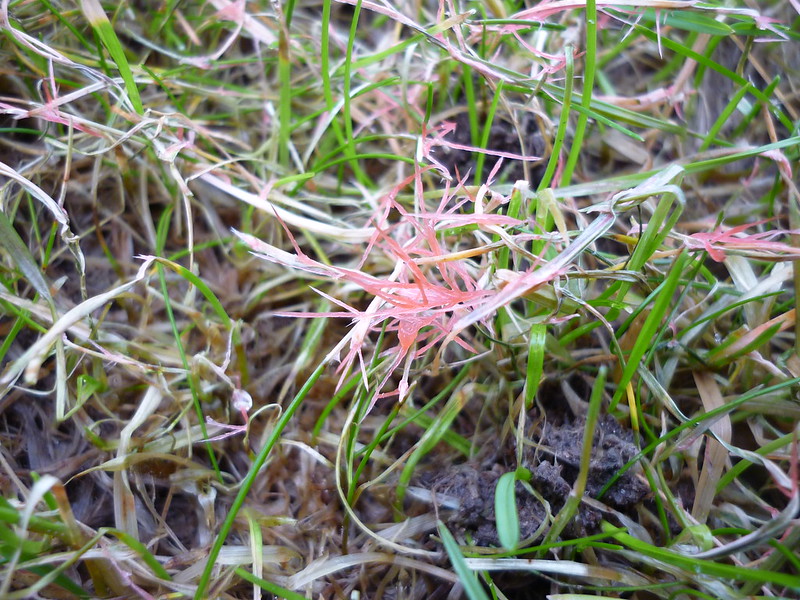Red thread disease is one of the most common fungal lawn diseases in the UK.
As the name suggests, this unsightly ailment is characterised by a reddish tinge. It is particularly prevalent in humid conditions.

Red thread lawn disease (photograph by Kris Lord)
If your lawn looks like the photo above, you're in the right place. This page is dedicated to all things red thread - including how to get rid of it.
What does red thread disease look like?
As far as textbook definitions go, red thread is often described as pink mycelium clusters. Sadly, that description doesn't translate well to most people walking the street, so it's probably better described as patches of fuzzy red thread - hence the name!
If your lawn has been unlucky enough to succumb to the dreaded reddy threads of this fungal fiend, you may notice your lawn becoming patchy in areas, with grass turning reddish-brown in colour.
In some cases, red thread can also be lighter in colour, with light pink patch grass forming; however, don't let its delicate colour fool you - it can be a real eyesore that can spread and spoil your green garden in no time.
What causes red thread disease?
Red thread disease can occur at any time throughout the year; however, it's most common during the later summer months and early autumn.
Red thread can easily develop in moist, humid conditions and is more likely to rear its reddish head during times of hot yet damp weather.
Poorly-aerated turf that's deficient in nitrogen is also the perfect platform for red thread to thrive. While it can affect a variety of grass lawns, red thread commonly affects red fescue, bentgrass and perennial ryegrass - three of the most common types of lawn grass in the UK.
Red thread can be easily spread through lawn mowing and transfer of spores through air and water. Meanwhile, red thread is also easily transported via contaminated tools or shoes, so be careful where you walk - don't tread on the thread!
The biology of red thread lawn disease
The thread-like structures found with red thread disease, also known as stromata, can survive on leaf debris and in the soil for up two years. The spread of the disease is caused by airborne or waterborne spores or on contaminated shoes and tools. Prolonged dampness on leaves is required for red thread disease to occur, so is most likely to be an issue during wet summers and heavy dews in autumn.
Red thread lawn disease is commonly produced on turf which is poorly aerated and deficient in nitrogen. Even if nitrogen is applied, heavy showers may wash it down below the root zone of the turf, particularly on light soils.
The fungus does not affect the root system of the grass and recovery may happen after a few days or weeks, even without remedial action. Persistent patches of red thread disease may require careful attention.
Red thread lawn treatment
Luckily, red thread is a surface problem and doesn't cause lasting damage to the roots beneath. As such, effective treatment can see your grass return to its natural green in a few weeks or even as little as just a few days' time.
- Chemical warfare - If you're looking to rip your red thread to shreds, the RHS recommends trifloxystrobin for red thread treatment. In the UK, this chemical can be found in many over-the-counter fungicide treatments, such as Bayer Garden. While these treatments can be used year-round, over-use could lead to the fungus developing immunity to the chemical, so be sure not to use more than twice a year to be safe.
- Non-chemical treatment - If you want to avoid using chemicals in your garden, applying nitrogen to the area can often suffice. However, this tactic isn't without its risks either. Application of nitrogen after August can lead to further infection in the form of snow mould.
- Wait and see - In some cases, red thread can disappear without treatment. That being said, if you're concerned enough to be reading about it, chances are that your red thread issue may warrant a once over by some fungicide. After all, the best form of defence is attack, right?
How to prevent red thread disease
It's often said that prevention is better than cure, so it's wise to pick up a few tips on how to avoid red thread disease and ensure it doesn't crop up again in the future.
Red thread disease can be avoided in a number of ways, most notably by ensuring your grass is well-drained and aerated. Forking and scarifying your lawn surface can significantly reduce the risk of red thread, as can effective fertilisation to ensure it doesn't become nitrogen deficient.
At Lawn & Weed Expert, we specialise in all of these lawn care techniques and can effectively prevent/treat red thread in your garden both thoroughly and professionally.
For more information on red thread disease and our range of garden treatments, why not give us a call today on 0800 111 4958? Alternatively, feel free to request a FREE garden survey using the button below and let us take an expert look at your garden today!
Request a FREE Survey >